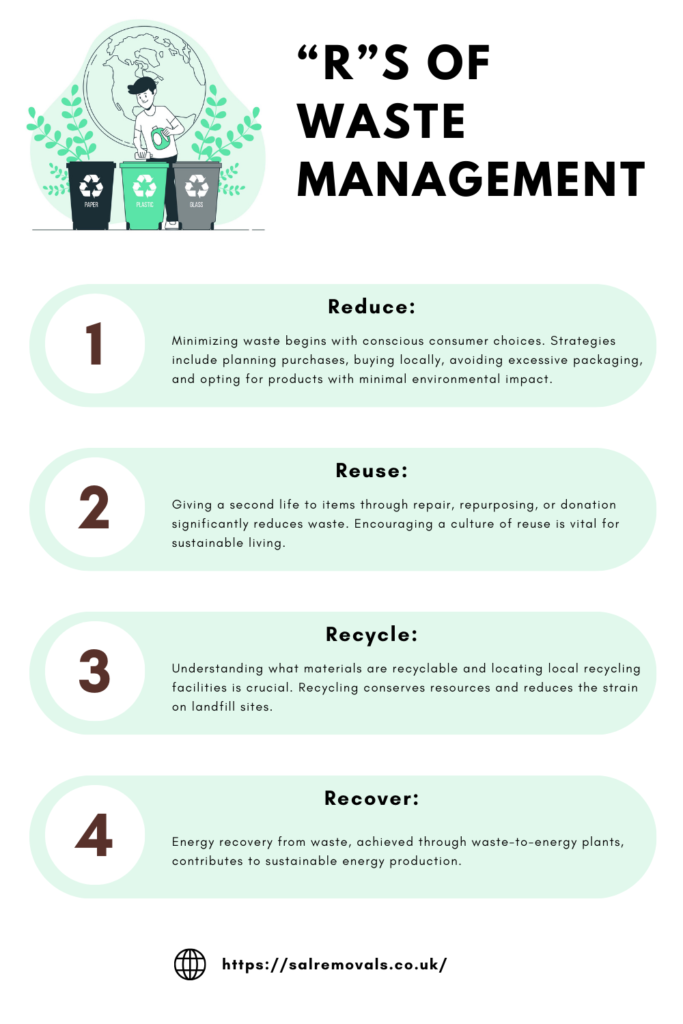Waste disposal is a critical aspect of modern living, with far-reaching implications for our environment and economy. In North London, waste removal is an integral part of maintaining a clean and sustainable community. Efficient waste disposal not only contributes to the well-being of our surroundings but also plays a pivotal role in fostering a healthier planet. In this comprehensive guide, we will delve into the nuances of waste management, emphasizing the importance of responsible waste removal in North London.
Improper waste management poses severe environmental and economic consequences. From pollution of air and water to the depletion of natural resources, the impact of unchecked waste disposal is profound. The concept of the “waste hierarchy” provides a structured approach to address this issue. The hierarchy, comprising Reduce, Reuse, Recycle, Rot, Recover, and Dispose, guides us towards sustainable waste management practices.
Understanding Waste
Waste comes in diverse forms, including household, commercial, industrial, and hazardous. Each category demands specific disposal methods due to their distinct characteristics. Proper sorting and segregation at the source are crucial steps in ensuring efficient waste management.
- Household Waste: Everyday items like packaging, food waste, and plastics.
- Commercial Waste: Generated by businesses and offices, including paper, electronics, and packaging.
- Industrial Waste: From manufacturing processes, often containing chemicals and heavy metals.
- Hazardous Waste: Potentially harmful materials requiring special handling and disposal.
The “R”s of Waste Management:
Reduce:
Minimizing waste begins with conscious consumer choices. Strategies include planning purchases, buying locally, avoiding excessive packaging, and opting for products with minimal environmental impact.
Reuse:
Giving a second life to items through repair, repurposing, or donation significantly reduces waste. Encouraging a culture of reuse is vital for sustainable living.
Recycle:
Understanding what materials are recyclable and locating local recycling facilities is crucial. Recycling conserves resources and reduces the strain on landfill sites.
Rot:
Composting organic waste at home provides a natural and environmentally friendly way to create fertilizer and enrich soil quality.
Recover:
Energy recovery from waste, achieved through waste-to-energy plants, contributes to sustainable energy production.
Disposal Methods:
Landfills:
Landfills, categorized as sanitary, municipal, or hazardous, are common disposal sites. They impact the environment and necessitate adherence to stringent regulations to minimize harm.
Incineration:
While incineration reduces the volume of waste and produces energy, it has drawbacks, including air pollution and the release of harmful emissions.
Other Treatment Technologies:
Innovative technologies like plasma gasification and pyrolysis offer alternative approaches to waste disposal, aiming for reduced environmental impact.
Special Considerations:
Hazardous Waste:
Special precautions are essential for the disposal of hazardous waste, including chemicals, batteries, and electronics. Strict adherence to safety protocols is imperative.
Construction and Demolition Waste:
Efficient handling and recycling of construction and demolition debris contribute to sustainable waste management practices in the building sector.
Medical Waste:
Strict regulations govern the disposal of medical waste to prevent the spread of infections and protect both healthcare workers and the general public.
Community Involvement:
The responsibility for effective waste management extends beyond individuals to governments and local authorities. A comprehensive waste management infrastructure, coupled with public awareness campaigns and educational programs, plays a pivotal role.
Government and Local Authorities:
Investment in waste management infrastructure and regulatory frameworks are essential for a systematic approach.
Public Awareness:
Educating the public about the importance of waste management fosters responsible behavior and a commitment to sustainable practices.
Individual Responsibility:
Adopting a sustainable lifestyle through reduced consumption, proper waste sorting, and participation in recycling programs is crucial for individual contributions.
The Future of Waste Disposal:
Emerging Technologies:
Advancements in waste management technologies, including robotics and artificial intelligence, are shaping the future of waste disposal.
Circular Economy:
Embracing circular economy principles, where products are designed for longevity and recyclability, can minimize waste production.
Building a Sustainable Future:
By integrating responsible waste disposal practices into our daily lives, we can collectively build a sustainable future for generations to come.
Conclusion:
In conclusion, effective waste disposal is a shared responsibility that requires collaboration at various levels. From individuals making conscious choices to governments implementing robust waste management systems, each contribution plays a vital role. By embracing the waste hierarchy, adopting the principles of the circular economy, and staying informed about emerging technologies, we can pave the way for a cleaner, healthier, and more sustainable future.




